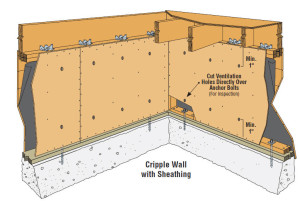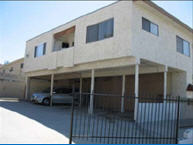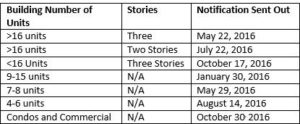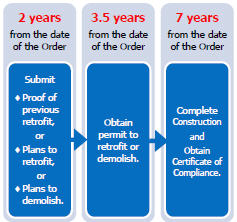House Bolting and Soft Story Retrofit Los Angeles, CA
Earthquakes. In Southern California, it's the natural disaster for which we're at greatest risk--and seismologists say we're long overdue for "the big one" (defined as a magnitude 8.0 or larger). In a sense, this lull period between major earthquakes has led many into a false sense of complacency--the longer time passes with no big shake, the more we think we have somehow been insulated from the danger, when in fact the likelihood only increases the longer we go without a major quake to relieve pressure on the San Andreas fault. There's no point in waiting to retrofit your building when the chances grow larger every day--knowing that your structure is able to withstand a major quake will save you money, and possibly your life.
Nielsen Environmental stands ready to strengthen your home with house bolting and soft story retrofit Los Angeles, CA residents need for the next big earthquake in the Beverly Hills, Malibu and Greater Los Angeles area. There are a few ways to help reduce the risk of damage to your home: 1) by securely bolting the sill plates to the foundation (aka foundation bolting); 2) reinforcing the cripple walls with structural grade plywood (cripple wall bracing); and 3) by attaching joist blocking and framing anchors between the floor joist. We have completed hundreds of foundation projects in residential homes and large courtyard apartment buildings. In our experience working closely with structural engineers, developers, landlords, property managers and homeowners since 1995, we can assure you that your house bolting project will be completed in a timely, safe, and professional manner.
Common Construction Problems in Los Angeles Neighborhoods
Many of the homes in Los Angeles were built using older construction techniques which are inadequate for the forces we now know earthquakes can cause, but these older homes can be reinforced easily. What follows is an explanation of what house bolting requires in older homes, and what can be done for modern homes still at risk as well.
Older Homes Are Typically Victims...
Homes built in Los Angeles prior to 1940, were built without being bolted to their foundations. Without this anchorage, a large earthquake can move ground and therefore the foundation right out from under the house. Older homes were damaged or destroyed in this manner by every major earthquake in California's history. For these homes, foundation bolting is a must during a retrofit.
...But Earthquakes Can Cripple Modern Anchored Homes too
Some wood frame homes built as recently as the 1970s were shaken off their foundations in recent earthquakes. Even though these modern homes were bolted down, they failed because of weak bracing materials on the cripple walls. The cripple wall is a short wall that connects the foundation to the first floor of the house and encloses the "crawl space". Weak bracing materials, like cement plaster (stucco) or wood siding, are not strong enough to survive the force of moderate to strong earthquakes. The cripple wall must be braced with stronger materials like plywood. If not, the next earthquake may damage the cripple wall and move your home off its foundation, even if you've bolted it down. In these cases, cripple wall bracing is essential to a retrofit.
Resources:
- Seismic Vulnerabilities Card seismic-vulnerabilities-card
- City of Los Angeles Prescriptive Standard PT14-App-A
- How You Can Strengthen Your Home For The Next Big Earthquake In the Los Angeles Area How-You-Can-Strengthen-Your-Home_L.A.
- Principals and Practice of Effective Seismic Retrofitting written by Bay Area Retrofit design_book
Los Angeles Soft Story Retrofit
Does my building require retrofitting?
See if your building was selected by the city of Los Angeles by entering your address in this database
How have the buildings been identified?
Buildings that are most vulnerable have been identified with the following criteria:
- Consist of 2 or more stories wood frame construction
- Built under code standards enacted before January 1, 1978
- Contain ground floor parking or similar open floor space.
The program does not apply to residential buildings with 3 units or less.
How much will it cost?
Typically cost is divided into three groups.
- Engineering Fees: $5,000 to $10,000
- Construction Costs: adding shear walls generally runs $5,000 to $10,000; cantilevered columns may be more space efficient, running between $15,000 to $20,000; for moment frames, the cost is generally $20,000 to $25,000 per installed, depending on the complexity of installation.
- Permitting Fees can be forecasted by using the LADBS permit calculator.
The LADBS has posted an Ordinance 183893 , which requires retrofit of pre-1978 wood-frame structures and soft story buildings
Apartment and Condo building owners have been notified; usually owners with 16 units or more are notified first.
How long do I have to comply before I take action?
- a-seismic-retrofit-program-property-owner-guide
- la-soft-story-retrofit-program-tenant-habitability-guide
- ss-program-permitting-and-inspection-process-guidelines
- ss-program-plan-check-correction-sheet-division-93-2014-labc
- ss-program-structural-design-guidelines
As can be seen here, house bolting and soft story retrofit Los Angeles, CA offers--whether it involves foundation bolting, cripple wall bracing, or more--is not only the best method of ensuring your building's earthquake preparedness, in some cases (particularly for older, pre-1978 homes) it is also required by city and state ordinances. Nielson Environmental will ensure that your house bolting procedure is in accordance with all ordinances and performed to the highest standards.
5 Tips To Protect Against Earthquake Damage
Earthquakes can cause significant damage to homes, but proper house bolting and soft story retrofit can help minimize the risk. At Nielsen Environmental, we understand the importance of protecting your home against earthquake damage as our team has over forty years of experience in this area. Here are five essential tips for house bolting to safeguard your property:
1. Assess Your Home's Vulnerability: Before starting any house bolting project, it's essential to assess your home's vulnerability to earthquake damage. Look for signs of foundation weakness, such as cracks in the walls or uneven floors. Additionally, consider the age and construction of your home, as older homes may be more susceptible to damage. If you see anything that worries you, then it’s time to call in a professional and move to tip number two.
2. Consult With A Professional: House bolting is a complex process that requires specialized knowledge and expertise. Before attempting any work yourself, consult with a professional contractor who specializes in house bolting and soft story retrofit. They can assess your home's specific needs and recommend the best course of action to protect against earthquake damage.
3. Use High-Quality Materials: When it comes to house bolting, the quality of the materials used is crucial. Opt for high-quality bolts, anchors, and hardware that are designed to withstand seismic activity. Investing in durable materials now can save you money and hassle in the long run by providing added protection against earthquake damage. Your contractor should be able to give you options on the materials used so that you can discuss what is the best quality.
4. Ensure Proper Installation: Proper installation is key to the effectiveness of house bolting. Make sure that all bolts and anchors are installed correctly and securely fastened to the foundation and framing of your home. Any mistakes or shortcuts during installation could compromise the integrity of the house bolting and put your home at risk during an earthquake. Be sure to work with a contractor you trust.
5. Stay Up To Date With Building Codes: Building codes and regulations related to house bolting and soft story retrofit may vary depending on your location. Stay informed about local building codes and ensure that your house bolting project meets or exceeds all necessary requirements. Compliance with building codes not only ensures the safety and stability of your home but also helps protect against potential liability in the event of an earthquake. Working with a contractor means you will not have to worry about these codes, they will stay up to date for you and be able to fill you in on any important updates to the codes.
By following these five essential tips for house bolting, you can better protect your home against earthquake damage and ensure the safety of your family and property. At Nielsen Environmental, we specialize in house bolting and soft story retrofit solutions to help homeowners mitigate the risks associated with seismic activity. Contact us today to learn more about our services and how we can help safeguard your home against earthquake damage.










